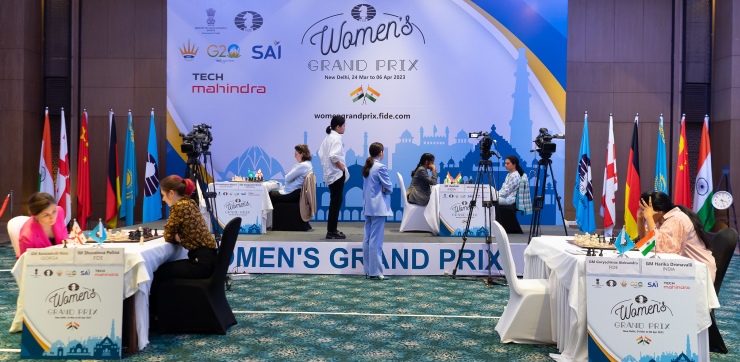WGP New Delhi: Round 9 Recap

Goryachkina secures a crucial win against Dronavalli and is hot on heels of tournament leader Assaubayeva who settles for a draw against Dzagnidze The Women’s Grand Prix in New Delhi entered its decisive phase as Round Nine unfolded, with players gearing up for the final push in the remaining days of the tournament. Here are the results of today’s games: Bibisara Assaubayeva – Nana Dzagnidze, ½ – ½Vaishali Rameshbabu – Humpy Koneru, ½ – ½Nino Batsiashvili – Polina Shuvalova, 1 – 0Aleksandra Goryachkina – Harika Dronavalli. 1 – 0 Kateryna Lagno and Zhu Jiner had a rest day. With just two rounds to go, Bibisara Assaubayeva is in the lead with 5½ points. After eight consecutive games (she was free on day one), Assaubayeva will not play in the tenth round as she has another rest day. She is closely followed by Aleksandra Goryachkina, who is in second place after today’s victory. Ju Jiner (who had a rest day today) is on 4½ points. In today’s round, Bibisara Assaubayeva drew in the Neo-Catalan against Nana Dzagnidze. Assaubayeva, playing as White, had more initiative but couldn’t find a way to convert it into a decisive advantage. In the end, both were happy with a draw. In another Catalan, Aleksandra Goryachina defeated India’s Harika Dronavalli. The Indian player had more initiative but misplayed in the middlegame and ended up with two pawns down. Despite putting up fierce resistance, Goryachkina brought her opponent to defeat after just over four hours of play. Round Nine was lucky for Nino Batsiashvili, who scored her first victory in the tournament. In the Nimzo-Indian, playing as White against Polina Shuvalova, she took advantage of Black’s mistakes in the middlegame and won. Compatriots Vaishali Rameshbabu and Humpy Koneru had a peaceful debate in the Ruy Lopez and agreed to split a point after 31 moves. Here follows a closer look at the games of Round Nine: Bibisara Assaubayeva – Nana Dzagnidze Before this game, the two played five games in total. The small number of games is probably because the two belong to different generations. Bibisara has three victories, while Nana has only one, with one game ending in a draw. In the Neo-Catalan accepted, Bibisara deviated from the played lines on move nine, castling her king (other previously played lines include 0-0, Nxd7 or Na3) and got a tiny edge thanks to two bishops. The first important moment happened on move 17. In the post-game interview, Dzagnidze said that she ‘wasn’t sure’ about the 17…f5 move, as it opens some weaknesses in Black’s camp. The game proceeded with a lot of positional regrouping around the centre, hoping to advance. However, it seemed that Black was the side which had to wait and react to White’s actions. Assaubayeva opted to exchange dark-squared bishops and prepare a d3-d4 push through the centre. After several inaccuracies by Nana, Bibisara obtained a serious advantage. She had isolated d4-pawn, but this factor was outweighed by her serious pressure in the centre and on Black’s downward e6-pawn. Dzagnidze tried to wriggle out by 33…Rxd4, and it worked, but only because Bibisara wasn’t precise. She took on e6 with her knight when it was better to play 34.Bc6 first and then take on e6 with a rook. Playing 34.Nxe6 straight away Bibisara overlooked 34…Rd1!, which allowed Black to exchange some pieces and simplify the position. White was still better, but by move 37, her advantage dissipated, and the two soon agreed to draw. With this draw, Bibisara Assaubayeva is still at the top, with 5½/9, while Dzagnidze has 2½ points. Vaishali Rameshbabu – Humpy Koneru This was another Indian clash. Out of 14 games played, Vaishali has three victories, while Humpy has six. In a rare line of the Ruy Lopez, the two quickly exchanged central pawns and the queens, heading towards an endgame in which Vaishali exerted some pressure on the queenside. The best option for White was 17.Na5, to probing Black’s weakness and hampering her development. Instead, Harika opted for 17.Be3, allowing Black to activate her c8-bishop. It led to an equal position, and the two soon agreed to draw. A fourth draw for Vaishali, who now has two points, while Koneru has 3½ points. Nino Batsiashvili – Polina Shuvalova The two have played four times so far, and Nino has two victories while Polina has one. In the Nimzo-Indian defence, the two entered the Saemisch variation and followed the footsteps of Salem and Moussard (Dubai 2021) up to move ten, where Nino deviated with a very aggressive but questionable 10.f3-f4?! White has an impressive pawn center but has to be careful of overstretching, as it can easily become a weakness. Polina hastily castled (10…cxd4 11.cxd4 h5 looks stronger), and a very sharp game was on. Shuvalova spent significantly more time in the opening, suggesting that she was surprised by White’s preparation. Still, she countered well by timely chipping away at White’s center by b7-b5 and got a potentially very strong connected c and d pawns. Black is clearly better here. Chess engines suggest 20…Rae8, but Polina preferred 20…Ne7 and then launched operations on the “wrong” flank and allowed White to push the b-pawn to b6, giving her some advantage. It was the start of Shuvalova’s fall. She made several inaccuracies in a row and found herself in a very dangerous position. Black needed to move her queen away from the pinned c-file and suffer after 27…Qf6 28.Nxf5 Qxf5 29.Be5. Shuvalova instead decided to take on d4, ending in a net of pins on the c5 pawn. White could have won on the spot on move thirty with 30.b7!, but Batsiashvili opted for 30.Qc3 and left some chances for Black. Still, Nino preserved a large part of her advantage. Shuvalova’s best option was to exchange her knight for the bishop on e5 but she played 33…d4? instead, further weakening her central pawns. The rest of the game was a walk in the park for White as her passers advanced much faster. Shuvalova soon resigned. It is the first victory for Nino Batsiashvili
Lei Tingjie wins Women’s Candidates Final

With a final score of 3½-1½, and with a game to spare, Lei Tingjie defeated Tan Zhongyi in the Women’s Candidates Final and will now challenge Ju Wenjun in the upcoming Women’s World Championship match, scheduled for July in Shanghai and Chongqing. In a must-win situation – a draw would leave Lei Tingjie with the white pieces in the last round with draw odds – Tan Zhongyi whipped out the Colle-Zukertort system, a rare bird in top-level events, but extremely popular at the club level. According to my database, in more than 600 official tournament games playing White, Tan Zhongyi has never employed this variation before: a risky choice for such an important game. The surprise effect didn’t work out. Lei Tingjie reacted fast, demonstrating splendid match-play opening preparation. She uncorked a novel idea (7…g6!?), delaying castling in favour of a dangerous kingside pawn avalanche. Although the line has been tried out on a few occasions by +2500 grandmasters in the past (notably Lopez Martinez and Cornette), it’s clearly not mainstream. By move 14, Black had already taken over the imitative on the kingside. Although the engines were still offering an equal evaluation, and the situation on the clock was also similar, it did feel that Lei Tingjie was playing aggressively to end the match here and now. The key moment of the game came unexpectedly. Under certain pressure on her castled king, Tan Zhongyi played 21.g3? breaking the golden rule of not moving the pawns in front of your king unnecessarily. Lei Tingjie’s masterful reply 21…Nd8!! highlighted immediately White’s new weaknesses in her castled king position. The manoeuvre Nd8-f7-g5-f3 would prove to be decisive. In the commentary booth, GM Alik Gershon was bowled over: “Wow! Look what Lei did: 21…Nd8! This is extremely impressive! She reacts immediately to 21.g3, which has a very serious drawback – it weakens the f3 square.” From then on, it was plain sailing for the new Women’s World Champion contender. All of Black’s pieces surrounded White’s king, and after 33…Rxg4 the attack crashed through and it was all over for Tan Zhongyi. A fine attacking game by Lei Tingjie that topped off her dominant performance in the match. Text: IM Michael Rahal Photo: Liu Yi Official website: womenscandidates.fide.com/ The match The 2023 FIDE Women’s Candidates Final is being disputed in Chongqing (China) from March 27th to April 6th. Chinese Grandmasters Lei Tingjie and Tan Zhongyi face each other in a six-game classical chess match. The winner will receive 60.000 euros and the right to challenge the current Women’s World Champion Ju Wenjun for the title in July. The venue Strategically positioned as a gateway to China’s west, Chongqing is China’s major modernized manufacturing base, a financial center, and an international transport hub in Western China. Home to more than 32 million people, it was an obvious choice for hosting the event as both players were born in the city. In addition, it’s an important center of chess activity in the country, abode to many important chess clubs and academies. A fun fact – both Lei Tingjie and Tan Zhongyi are teammates at the Chongqing Sports Lottery Chess Club.

